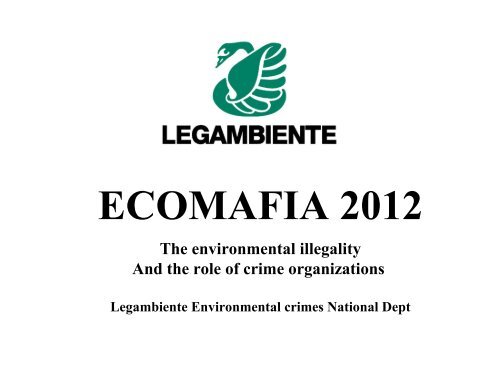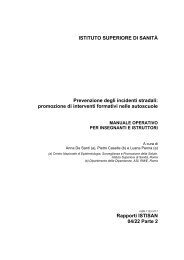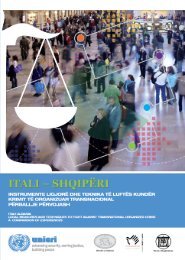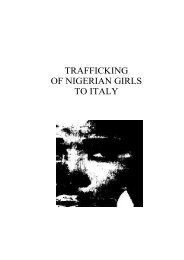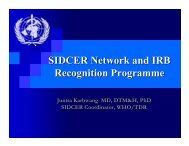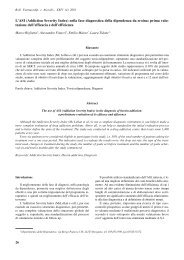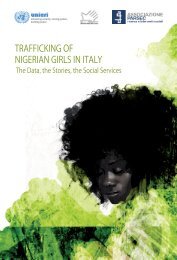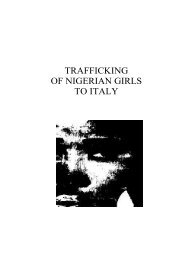Mr. Antonio Pergolizzi, Coordinator, Observatory ... - UNICRI
Mr. Antonio Pergolizzi, Coordinator, Observatory ... - UNICRI
Mr. Antonio Pergolizzi, Coordinator, Observatory ... - UNICRI
You also want an ePaper? Increase the reach of your titles
YUMPU automatically turns print PDFs into web optimized ePapers that Google loves.
ECOMAFIA 2012<br />
The environmental illegality<br />
And the role of crime organizations<br />
Legambiente Environmental crimes National Dept
Ecomafia, a neologism<br />
• 1994: ecomafia is the word that Legambiente<br />
coins to describe the attack to the environment<br />
by the mafia organizations<br />
• 1999: ecomafia term is included in the italian<br />
most important dictionary as “mafia’s branch<br />
which manages activities higly dangerous for the<br />
environment, as unauthorised building and<br />
illegal toxic waste disposal”.
Not only mafia<br />
• Business man<br />
• lawers<br />
• white collars<br />
• politicians<br />
• etc.
It is better talking about “Criminal<br />
system”
Interpol definition<br />
“Environmental crime is a serious and<br />
growing international problem, with<br />
criminals violating national and<br />
international laws put in place to protect<br />
the environment. These criminals are<br />
polluting the air, water and land. They<br />
are pushing commercially valuable wildlife<br />
species closer to extinction and they are<br />
significantly impacting the biological<br />
integrity of the planet.”
The Ecomafia’s fields<br />
• Illegal building<br />
• Waste illegal traffic<br />
• Animals illegal trade and abuse<br />
• Trafficking in cultural goods and works of<br />
art<br />
• Forest fires, (public water stealing),<br />
illegality in food chain
The Legambiente environmental<br />
crimes department<br />
• October 1994: Legambiente sets up the permanent dept on the<br />
environmental crimes, working with its local groups, advisers and<br />
lawyers, public prosecutor’s offices, journalists, etc<br />
• The department, first in Italy, creates a connextion between police<br />
forces and an environmental association<br />
• Legambiente publishes the first Ecomafia Annual Report<br />
• At present Ecomafia Annual Report is a basic text for those who are<br />
acting against environmental crimes. The Legambiente dept also<br />
works with the National antimafia bureau, where has been created a<br />
specific team on ecomafia crimes
Ecomafia 2012 in numbers<br />
• Total amount of environmental crimes: 33.817<br />
(92 a day, more than 3,8 per hour)<br />
• Arrested people: 305<br />
• Reported people: 27.969<br />
• Seizures: 8.765<br />
• Involved mafia families: 296 (+6)<br />
• Estimated turnover: 16,5 mld €<br />
• (about 25% of the total mafia’s business amount)
L’incidenza per settori<br />
Illegalità Ambientale 2011<br />
Delitti contro la Fauna<br />
22%<br />
Altri reati ambientali<br />
16%<br />
Ciclo Rifiuti<br />
16%<br />
Incendi Dolosi Colposi<br />
Generici<br />
23%<br />
Archeomafia<br />
3%<br />
Ciclo cemento<br />
20%
“Waste S.p.a.”<br />
• “..no mister, no more drugs. Now I started a new<br />
business. Is more profitable and even safe: it’s called<br />
monnezza (garbage), my friend. Because, believe me,<br />
monnezza is better than gold”<br />
(December 1992, Naples mafia informer Nunzio Perrella<br />
to the public prosecutor Franco Roberti)<br />
• It is clear how much Naples mafia is involved in the<br />
illegal waste trafficking and disposal, enhanced by the<br />
lack of law and some complicity inside institutions<br />
• Yearly waste trafficking business is about 7 billions of<br />
euros
The italian best practice<br />
• In 2001 the national parliament carried a<br />
bill concerning the crime of “organized<br />
activity of illegal waste trade”, art. 260<br />
Dlgs 152/2006.<br />
• Since that moment the italian legislation<br />
makes an important step ahead in fighting<br />
waste trafficking.<br />
• It should be extended to all EU countries
Investigation over illegal waste<br />
trafficking: some numbers<br />
Since 2002:<br />
• 199 investigations have been completed<br />
• 676 companies<br />
• 87 Public prosecutor offices have been involved<br />
• 1.229 arrested people (over 3.650 reported)<br />
• 23 foreign countries involved (10 in Europe:<br />
(Austria, Bulgaria, France, Germany, Greece, England,<br />
Norway, Russia,Hungary, Turkey)
Campania record<br />
• It's extimated that 13 million tons of waste<br />
(using some 520.000 trucks) have been<br />
illegally disposed during the last three<br />
years in Campania region, generating a<br />
business valued about 4 billions of euros.
Cultivated land in Caserta province: illegal disposal of<br />
toxic waste used as fertiliser (photo taken by Police<br />
force).
The ecomafia “mountain range”<br />
According to the Ministry of Environment, in 2006 in Italy<br />
disappeared 31 million tons of hazardous wastes,<br />
representing the difference between the amount<br />
produced by the industries and the legal disposal
It’s a mountain made of waste,<br />
with a 3 ha of base and 3.100 metres high,<br />
The same as the Etna volcano in Sicily.
• Considering only the inquires where data<br />
are available (most of them are unknown),<br />
in the last two years policies have been<br />
seizing 2,4 milions tons of hazardus waste<br />
• This quantity needs about 96.030 trucks to<br />
be trasported, and if we image these<br />
trucks in a row, it would cover the road<br />
from Reggio Calabria to St. Morizt in<br />
Switzerland
The ecomafia’s road
The business of illegal building<br />
This criminal sector goes from the illegal exploitation of quarries and<br />
sand drawing from rivers and beaches until the unauthorised<br />
building, in public areas as well as in private ones.<br />
It also concerns criminal presence in public procurements.<br />
Unathorised building of villas, tourist resort and hotels along the<br />
most beutiful sea coasts or inside protected natural areas is<br />
economically advantageous.<br />
This illegal practice is diffused all over the country, but is more<br />
serious in southern regions (Campania, Puglia, Calabria and Sicily),<br />
where it crosses the interests of the mafia organizations.<br />
In 1985, in 1994 and again in 2003, the italian parliament voted a<br />
general building amnesty.
2011 – Some numbers describing<br />
the illegal building crime field<br />
• Illegal buildings: 25.800<br />
• Crimes: 6.662<br />
• Reported people: 8745<br />
• Arrested people: 20<br />
• Seizures : 1.964
Quarries: from cement to waste<br />
The thousands of quarries all over the country<br />
are the starting and ending point of the Ecomafia<br />
criminal activities:<br />
• are the symbol and the means by wich mafia<br />
can have the control of the territory. And also the<br />
source of very cheap raw material for concrete<br />
• at the same time the holes are perfect places to<br />
dispose special waste.
Campania: a region of records<br />
• 70% of the Campania municipalities under judicial administration<br />
(because of mafia presence) are as a consequence of illegal<br />
building practices.<br />
• At Giugliano, a town near Naples, the public prosecutor office<br />
arrested 32 policemen. They were part of a gang running the<br />
business of illegal building inside the local police headquarter<br />
offices.<br />
• In the Agro-sarnese-nocerino district (158 squared kilometres) more<br />
than 300.000 squared metres of land has been occupied by illegal<br />
concrete in 4 years. Over 27.000 persons has been denounced in<br />
20 years (10% of the entire population).
Houses on waste.<br />
Quarto Flegreo (Naples): the seizure of a site where a<br />
company is building houses on illegal waste disposal
Eco Monsters<br />
Punta Perotti<br />
(Bari promenade)
Pizzo Sella’s hill<br />
(Palermo-Sicily)
Alimuri, Vico Equense (Naples)
Alimuri
Air field in Scalea district<br />
(Cosenza – Calabria)<br />
Pollino Park<br />
Houses<br />
Lao River<br />
S.S. 18<br />
Tirreno Sea
“Pilework house”<br />
Falerna (Calabria).
2.800 houses along the 10 km coast<br />
between the sea and the Lesina lake.<br />
Torre Mileto illegal village (Lesina – Puglia)
A hause in Verbone<br />
(Imperia - Liguria)
Mobile house on the beach<br />
Falerna (Calabria)
An illegal medieval castle<br />
built in the Caserta district<br />
(Sant’Angelo d’Alife)
Ecomafia and natural disasters<br />
The cement abuse and the illegal buildings<br />
multiply the hydro and geological<br />
instability.<br />
An event which interests 82% of the italian<br />
municipalities.
Maierato’s landslide (Vibo<br />
Valentia - Calabria), 18 feb 2010
San Fratello landslide effect<br />
(Messina - Sicily).<br />
Feb 2010
,<br />
The landslide in Messina (Sicily)<br />
37 victims - Oct 2009
Ecomafia worldwide<br />
Ecomafia is itself an international business,<br />
operating through a system of routes<br />
all over the world.<br />
The differences between national legislations<br />
and the difficulties to plan joint actions<br />
give to the criminal organizations a considerable<br />
advantage
International Waste Trafficking<br />
• Since the seventies to send industrial and<br />
radioactive waste to the poorest areas of<br />
the world is a big business.<br />
• Specialized companies make good<br />
earnings<br />
• A case is the one known as “Poisoned<br />
shipments”, the misterious wreck of<br />
many cargos in the Mediterranean Sea<br />
between ’70 and ’90)
We are talking about one of the most<br />
important economic issue
Italian Customs Agency<br />
In 2011 seized 7.400 tons of hazardous<br />
waste leaving for abroad<br />
In the last three years Italian Customs<br />
seized more than 40.000 tons of waste<br />
leaving for foreign contries<br />
Destination countries are mainly in South<br />
East Asia (China and Hong Kong) and<br />
Africa
One of the most used concealment tecnique is to hide eletronic<br />
waste behind a front row of pc monitors packed up and still<br />
functioning.
We just considering…
East and west waste<br />
• Italian companies pay about 60.000 €<br />
to dispose legally a container full of 15.000<br />
tons of hazardous waste.<br />
• The same amount of waste can be<br />
disposed illegally for 5.000 € in eastern<br />
countries.
QuickTim e e un<br />
decom pres s ore<br />
s ono neces s ari per vis ualizzare ques t'im m agine.
QuickTim e e un<br />
decom pres s ore<br />
s ono neces s ari per vis ualizzare ques t'im m agine.
QuickTim e e un<br />
decom pres s ore<br />
s ono neces s ari per vis ualizzare ques t'im m agine.
Operation “Demeter”<br />
may 2009<br />
• Is the first international operation directed<br />
by the World customs organization (Wco)<br />
• It involved 64 nations and seized over<br />
30.000 tons of hazardous waste
Operation “Great wall”<br />
In 2007 Police forces in Reggio Calabria<br />
together with the Customs office stopped a<br />
great illegal waste traffic in Gioia Tauro<br />
harbour. Cargos were sailing to China,<br />
India, Russia and North Africa.
“Great wall” in numbers<br />
Inside the 135 seized containers<br />
• 740 tons of plastic<br />
• 1.570 tons of metals<br />
• 150 tons of electricity meters<br />
• 700 tons of paper<br />
• 10 tons of car parts and tires
The kind of waste sized in Gioia Tauro harbour ready<br />
to leave to the chinese villages to be sorted and<br />
processed without any care for workers health and for<br />
the environment.
The harbours<br />
• Seaports are the places where most of the illegal trafficking<br />
happen.<br />
• In the coming and going containers, waste, protected animal<br />
species, expired or counterfeit food, etc… are often hidden
The mistery of Poisoned Shipments<br />
• A lot of official documents speak about the illicit<br />
sinkings. In 2001 parliamentary special commission<br />
wrote about 39 wrecks in the mediterranean sea full<br />
of chemical and nuclear waste.<br />
• Italian public tv journalists Ilaria Alpi and Miran<br />
Hrovatin were killed in Mogadiscio in 1994 while<br />
investigating on waste and arms illicit trafficking<br />
from Italy to Somalia.<br />
• Navy investigator Natale De Grazia died in 1995 (in<br />
unclear circumstances) while he was searching the<br />
truth about the suspicious sinking of 27 ships.
Eu directive 2008/99/ce<br />
• It finally introduced in Europe the protection of the<br />
environment through criminal law, giving a common<br />
legislation to all the Eu countries<br />
• The Italian Parliament transposed the act on June 2010.<br />
A year later (july 2011) the Italian Government has ratied<br />
it (Decreto n.145), so the Directive became law<br />
• In concrete, in Italy nothing has been changed
• Only through the cooperation between Customs, Police<br />
forces and Public prosecutor offices of all the countries it<br />
will be possible to settle an effective control and<br />
punishment politicy.<br />
• EU countries should share best practice<br />
• It’s also necessary to strenghten the EU legislation and<br />
the intelligence activity against the illegal movements of<br />
waste.


